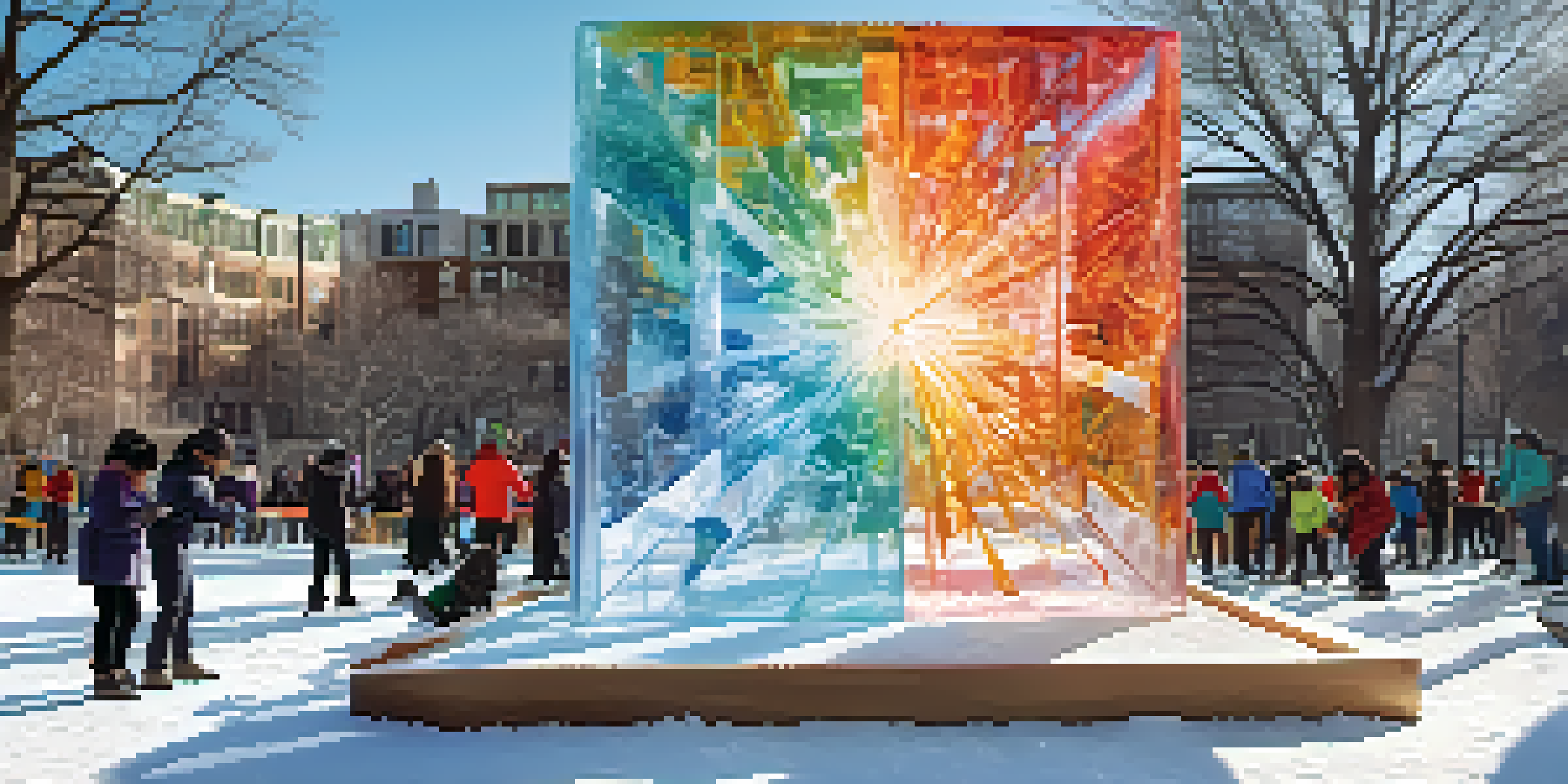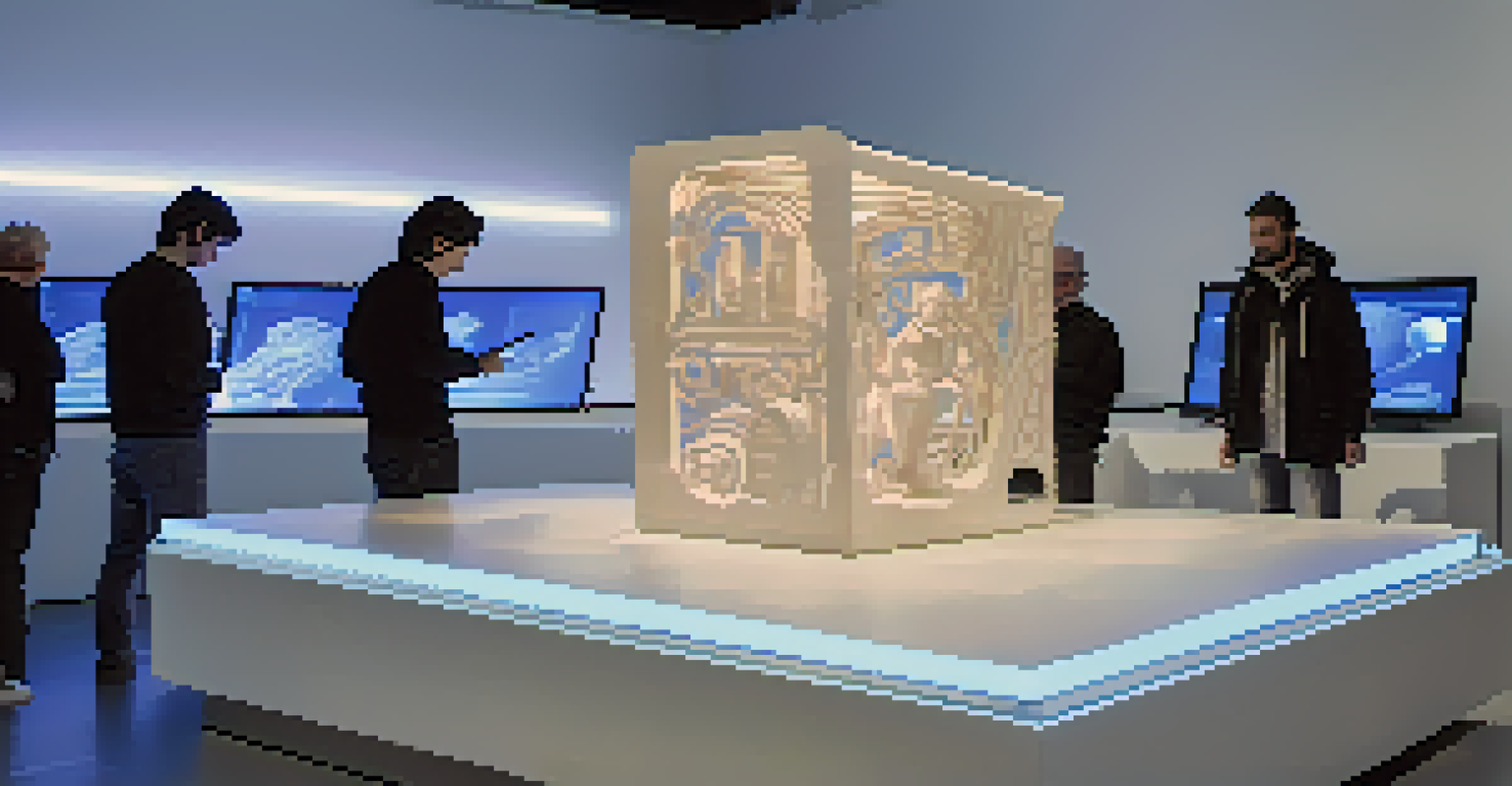Interactive Carving: Engaging Audiences in Public Installations

What is Interactive Carving in Public Installations?
Interactive carving refers to art installations where the audience can engage with the artwork, often through physical interaction. This concept transforms traditional viewing into a participatory experience, inviting people to become co-creators. Imagine walking up to a large block of ice or wood and being encouraged to carve or shape it; that’s the essence of interactive carving.
Art is not what you see, but what you make others see.
These installations can vary from simple, hands-on activities to complex, technology-driven experiences that blend art and innovation. For instance, in some installations, attendees use tools to carve out their designs, while others may use digital interfaces to manipulate visual displays. This interactivity fosters a deeper connection between the audience and the artwork, making art more accessible and engaging.
Ultimately, interactive carving encourages creativity and self-expression, allowing participants to leave their mark on the installation. This not only enhances personal connections to the art but also strengthens community ties as people collaborate and share their experiences. In a world where art often feels distant, interactive carving brings it closer to home.
The Benefits of Engaging Audiences Through Art
Engaging audiences through interactive art installations offers numerous benefits, both for the artists and the participants. First and foremost, it creates memorable experiences that resonate long after the event ends. When people interact with art, they are more likely to recall their experiences and share them with others, effectively spreading the word about the installation.

Moreover, these experiences can spark creativity and inspire new ideas in participants. By allowing individuals to express themselves through carving or shaping materials, they tap into their artistic instincts, often discovering hidden talents in the process. This empowerment can lead to a greater appreciation for art and its role in personal expression.
Interactive Art Encourages Participation
Interactive carving transforms traditional art viewing into a participatory experience, allowing audiences to engage creatively.
Finally, interactive installations can foster community engagement, drawing diverse groups of people together. When individuals collaborate on a collective piece of art, it cultivates a sense of belonging and shared purpose. This communal aspect not only enhances the overall experience but also strengthens social bonds within the community.
Examples of Successful Interactive Carving Installations
Several notable interactive carving installations have captured the imaginations of audiences worldwide. One such example is the 'Ice Sculpture Festival' held annually in various cities, where attendees can participate in carving massive ice blocks. This event not only showcases the talent of professional sculptors but also invites the public to try their hand at carving, resulting in a vibrant, collaborative atmosphere.
Creativity takes courage.
Another inspiring example is the 'Wooden Block Project,' where communities are given wooden blocks to carve and decorate. The finished pieces are then assembled into a larger installation, creating a stunning display of collective creativity. This project highlights how individual contributions can come together to form a cohesive and beautiful work of art.
These examples illustrate how interactive carving can transform public spaces into lively hubs of creativity. By inviting participation, these installations break down barriers and make art more inclusive, allowing everyone to experience the joy of creation.
How Technology Enhances Interactive Carving Experiences
Technology plays a significant role in enhancing interactive carving experiences, allowing artists to push the boundaries of traditional installations. For instance, augmented reality (AR) can be integrated into carving projects, enabling participants to visualize their creations in 3D before they begin. This fusion of technology and art not only adds an exciting layer to the experience but also helps participants feel more confident in their abilities.
Additionally, digital tools can streamline the carving process, making it more accessible to those unfamiliar with traditional techniques. For example, laser cutters and CNC machines can assist in creating intricate designs, while still allowing for human input and creativity. This combination of technology and hands-on interaction keeps the essence of carving alive while expanding what’s possible.
Community Engagement is Key
Collaboration in interactive carving projects fosters a sense of belonging and strengthens social bonds within communities.
Moreover, technology facilitates the sharing of these experiences online, as participants can document their work and share it on social media. This not only creates a digital footprint for the installation but also encourages others to engage with future interactive art projects. Technology, therefore, acts as a bridge between physical and digital art, enhancing the overall experience.
The Role of Community in Interactive Carving Projects
Community involvement is crucial for the success of interactive carving projects, as it fosters a sense of ownership and pride among participants. When communities come together to create art, they cultivate a shared identity and strengthen social connections. This collaborative spirit often leads to lasting friendships and networks that extend beyond the installation itself.
Moreover, involving local artists and artisans can enrich the experience and provide valuable learning opportunities for participants. Workshops led by skilled craftsmen can teach essential techniques, empowering individuals to explore their creativity in new ways. This mentorship not only enhances the quality of the art produced but also helps preserve traditional carving techniques.
Ultimately, community engagement transforms interactive carving into a meaningful experience that resonates deeply with participants. By working together, individuals can express their collective identity through art, contributing to a vibrant and dynamic cultural landscape.
Challenges in Implementing Interactive Carving Installations
While interactive carving installations offer numerous benefits, they also come with their own set of challenges. One of the primary concerns is ensuring safety during the carving process, especially when participants are using tools or working with heavy materials. Organizers must put safety measures in place, including providing proper training and supervision to minimize risks.
Additionally, securing funding and resources can be a significant hurdle for many projects. Interactive installations often require materials, tools, and space, which can be costly. Therefore, artists and organizers need to be resourceful in seeking grants, sponsorships, or community partnerships to bring their visions to life.
Technology Enhances Art Experiences
The integration of technology, such as AR and VR, expands the possibilities of interactive carving, making the experiences richer and more engaging.
Finally, striking a balance between artistic intent and participant freedom can be tricky. While the goal is to encourage creativity, it’s essential to maintain the integrity of the artwork. Clear guidelines and supportive frameworks can help navigate this challenge, ensuring that both the artist’s vision and the participants’ contributions are honored.
Future Trends in Interactive Carving and Art Installations
As the world of interactive carving evolves, several trends are emerging that promise to shape the future of public art installations. One notable trend is the increased integration of sustainable materials and practices. As awareness of environmental issues grows, artists are exploring ways to use recycled or eco-friendly materials in their projects, promoting sustainability while engaging audiences.
Moreover, advancements in technology will continue to play a pivotal role in interactive art. We can expect to see more installations incorporating virtual reality (VR) and artificial intelligence (AI) to create immersive experiences that push the boundaries of traditional carving. These innovations will not only enhance interactivity but also expand the ways in which audiences can engage with art.

Finally, the rise of social media will further influence how interactive carving projects are designed and executed. Artists will likely focus on creating shareable experiences that resonate with online audiences, encouraging participants to document and share their interactions. This emphasis on social sharing can elevate the visibility of these installations, attracting larger audiences and fostering a culture of creativity.